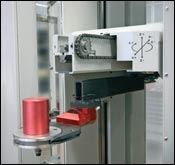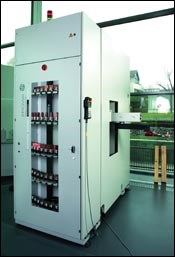Compact Handling Facility Sticks To Basics
Shops consider a number of factors when justifying automated parts storage systems, including cost, required floor space and machining application.
Share




Shops consider a number of factors when justifying automated parts storage systems, including cost, required floor space and machining application. A clever use of configurable storage racks in place of rotating magazines keeps the design of Erowa’s Robot Compact handling facility simple and affordable for shops of all sizes. The racks are internal to the robot, so the system occupies little space on the shop floor and can get very close to the machine tools it serves. The robot is designed especially for manufacturers of small parts such as medical components and EDM electrodes.
The robot is most useful for shops that need immediate productivity improvements but can’t afford to spend time and money implementing larger, more complicated solutions, says Bob Byers, vice president of sales and marketing at Erowa. Increased customer demand, more exacting tolerances, new jobs involving geometrically complex parts—all these factors can drive shops to seek technological solutions for improving productivity. Often, however, purchasing the latest machine tools and other equipment isn’t always possible or even necessary, Mr. Byers explains. A more economical solution is to find a way to increase the productivity of existing equipment.
“In the era of ‘bigger, faster, stronger,’ we’re going back to a very simplistic approach with the Robot Compact,” Mr. Byers says. “Most people think they need a wholesale change in their shop, but sometimes tweaking one little area can increase profits. Starting out small with something very simple that can increase the productivity of the machine tool is huge.”
With that in mind, the robot is designed to be easy to install and operate. The racks used to store workpiece pallets are easier to change out than a rotary magazine system, Mr. Byers says. This allows shops to easily reconfigure the system for different applications. Moreover, with the racks mounted inside the system to the left and right of a small gripping arm, all movement is internal to the robot. This configuration keeps the robot’s footprint to 2 square meters and allows installation right next to machines with virtually no gap. Despite its small size, the Robot Compact features 160 pallet positions. It can supply one or two machines with pallets weighing 30 kilograms or less.
“This is something a shop can implement, make money from and see immediate benefits without a lot of investment in time and money,” Mr. Byers concludes.
Related Content
-
Which Approach to Automation Fits Your CNC Machine Tool?
Choosing the right automation to pair with a CNC machine tool cell means weighing various factors, as this fabrication business has learned well.
-
4 Steps to a Cobot Culture: How Thyssenkrupp Bilstein Has Answered Staffing Shortages With Economical Automation
Safe, economical automation using collaborative robots can transform a manufacturing facility and overcome staffing shortfalls, but it takes additional investment and a systemized approach to automation in order to realize this change.
-
Lean Approach to Automated Machine Tending Delivers Quicker Paths to Success
Almost any shop can automate at least some of its production, even in low-volume, high-mix applications. The key to getting started is finding the simplest solutions that fit your requirements. It helps to work with an automation partner that understands your needs.



























